How We Modernized a Legacy App using Power Platform
In May, AIS held an internal hackathon for Microsoft Power Platform to expose our team to the platform, concepts, approaches through hands-on experience and to demonstrate the role Power Platform plays in modernizing legacy applications in the cloud.
The Microsoft Power Platform Hackathon was an opportunity for our enthusiastic team to modernize a legacy e-commerce (E-shop) application using Microsoft Power Platform. The legacy application, the deployment of eShopOnWeb, helped users find a product of interest by browsing and filtering. Users could also add products to their cart and checkout. The app also provided an interface for administrators to add, update, or delete products from the catalog. The idea behind this hackathon was that we could build this application on top of the Microsoft Power Platform or Low Code application platform instead of using classic ASP, ASP.NET, and GSP. We wanted to write the application using Power Portal to drag and drop to use existing components.
A new system was developed to replace the legacy e-commerce application with the complete feature parity. The solution included a Power Apps Portal with the same “look and feel” functionality. We used Dataverse as the persistent layer instead of SQL server and integrated it with new communication methods such as sending emails and text messages to users. Additionally, we used a Web API to communicate with Legacy Reporting Systems using Power Platform Connectors, providing secure access to the new system using Azure Active Directory B2C.
In addition, the team explored ways to backup and source control the solution and automate the deployment from one environment to another. The diagram below represents the architecture of our final solution.
It is named ‘Work Less, Do More,’ Power Platform replaces the work that might take many days or months to a few hours. So let’s dive in and learn how we arranged all these pieces and modernized the legacy application using Microsoft Power Platform.
JOIN OUR GROWING TEAM
AIS provides employees with opportunities to learn and grow in their careers. Won't you join us?
Technical Approach
Our main motivation was to identify the appropriate approach to bring applications to scale. Our innovative approaches and technical depth have earned us the privilege of experience in designing, implementing, and modernizing some of the most complex cloud solutions. The application was divided into different components, which were developed by individual teams. All the components were then pulled together to provide the complete Power app solution.
When dealing with legacy applications, we looked at past examples of our approaches from experience and have outlined them below:
- Rehost: A direct cloud lift and shift. This is a faster, less resource-intensive migration that moves your apps to the cloud without any code modification. The rehosting approach to app modernization is capturing the on-prem environment that runs an application (the servers) and directly moving that to the cloud as virtual servers. In this approach, the environment hosting the application is modernized, but the core application itself is not significantly offered.
- Refactor: This approach is about modernizing legacy applications by rearchitecting to target cloud-native “serverless” technologies where possible. Refactoring typically requires more significant recoding of the existing application, however, this method takes advantage of the best of what the public cloud has to offer – managed offerings for all application components. In this approach, we re-architect existing applications and deploy them as Platform as a Service (PaaS).
- Replatform: Essentially, this approach is somewhere in between Rehost and Refactor, because the entire VM is not moving to the cloud. This application will be containerized and run on top of Kubernetes.
- Reimagine: This is typically thought of as a Greenfield cloud-native rewrite, which is why code changes are high, even though you will eventually end up with a low operating cost.
The idea of Power Platform and low code applications is that you can get to the Reimagine approach without having to spend a lot of effort in building a cloud-native application.
In this section, we are going to highlight these components and how they were implemented in our solution:
The front-end team focused on building the Power Apps Portal for the end-users and a model-driven app for the administrators. The Portal allowed the users to browse through the product catalog, add an item to the cart, place an order, view their past orders, and manage their profile. The model-driven app allowed administrators to manage the product catalog just like the legacy application. The team used Portals Web API to fetch data from Dataverse and used Liquid templates for web pages.
The data team focused mainly on using Microsoft Power Platform Dataverse as the persistent layer for both the Portal and the admin app. They also migrated schema and data from legacy datastore to Dataverse by exploring various techniques, including Dataflows, CSV imports, and custom code.
The integration team focussed on leveraging existing Power Platform connectors to add new functionality to the system. For example, the system sends the order confirmation email to the user using the Office Outlook connector in the Power Automate Flow. Similarly, it sends text messages to users through the Twilio Connector. The team also leveraged SQL Server Connector for data sync so that the legacy reporting systems remained unaffected.
The DevOps team automated the portal deployment process using Power DevOps Tools and deployed the solution across three environments (dev, test, prod). Since Microsoft Power Platform does not support source control and versioning, the team used Azure DevOps as the solution repository and version control.
The identity team focused on providing secure access to the Portal to a different set of users. The team used Azure AD B2C to decouple identity and access management from the Portal application.
Stay tuned! We will be publishing a blog for each team for a deeper dive into their individual focuses for this hackathon.
Lessons Learned
Ultimately this hackathon proved that Power Platform is a great app modernization solution for the following reasons.
- We can use Portal as a modern low code alternative to create websites and interact with data in Dataverse.
- Model-driven apps provide a rich no-code design environment to create applications and share quickly.
- We can quickly build secure apps using connectors.
- Innovate and improve business, as these connectors are easily customizable, and end-users can easily change or create the content for Email or SMS Templates.
- With the help of Power Platform build tools, we can quickly deploy the solution into various environments. Increase the release frequency.
MEETING NEEDS QUICKLY WITH POWER PLATFORM
AIS architected, developed, and deployed a secure global health solutions management application and digital marketplace built on Power Platform.
Thank you to the Internal Power Platform Hackathon Technical Deep Dive team
Authored by Lav
Covers experience from all teams:
Front end
Ritika Agarwal (team lead)
Devyanshi Tiwari
Pooranendu Patel
Data
Jagrati Modi (team lead)
Souradeep Banerjee
Nikhil Grover
Integration
Kranthi Kiran (team lead)
Varalika Bishnoi
Sravan Kumar
Pavan Bandi
DevOps
Vikram Reddy (team lead)
Identity
Lav Kumar (team lead)
Davood Khan
Recommended Reads
-
-
- Use the Microsoft Dataverse Web API
- Perform operations using the Web API
- https://docs.microsoft.com/en-us/powerapps/maker/model-driven-apps/
- https://docs.microsoft.com/en-us/powerapps/maker/portals/
- Microsoft Power Platform Build Tools for Azure DevOps – Power Platform | Microsoft Docs
- Build tool tasks – Power Platform | Microsoft Docs
- Power Apps Build Tools for Azure DevOps | Developer Support (microsoft.com)
- Automate Dynamics 365 & Power Platform Deployment using Azure DevOps CI/CD
-







